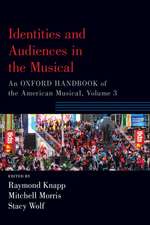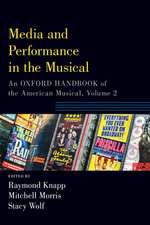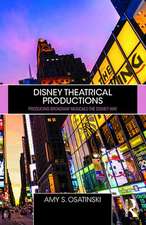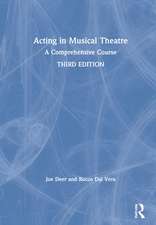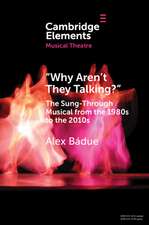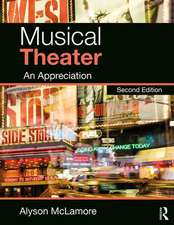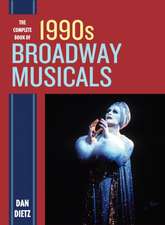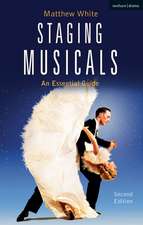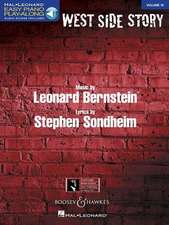Finishing the Hat: Collected Lyrics (1954-1981) with Attendant Comments, Principles, Heresies, Grudges, Whines and Anecdotes
Autor Stephen Sondheimen Limba Engleză Hardback – 30 sep 2010
Along with the lyrics for all of his musicals from 1954 to 1981—including West Side Story, Company, Follies, A Little Night Music and Sweeney Todd—Sondheim treats us to never-before-published songs from each show, songs that were cut or discarded before seeing the light of day. He discusses his relationship with his mentor, Oscar Hammerstein II, and his collaborations with extraordinary talents such as Leonard Bernstein, Arthur Laurents, Ethel Merman, Richard Rodgers, Angela Lansbury, Harold Prince and a panoply of others. The anecdotes—filled with history, pointed observations and intimate details—transport us back to a time when theater was a major pillar of American culture. Best of all, Sondheim appraises his work and dissects his lyrics, as well as those of others, offering unparalleled insights into songwriting that will be studied by fans and aspiring songwriters for years to come.
Accompanying Sondheim’s sparkling writing are behind-the-scenes photographs from each production, along with handwritten music and lyrics from the songwriter’s personal collection.
Penetrating and surprising, poignant, funny and sometimes provocative, Finishing the Hat is not only an informative look at the art and craft of lyric writing, it is a history of the theater that belongs on the same literary shelf as Moss Hart’s Act One and Arthur Miller’s Timebends. It is also a book that will leave you humming the final bars of Merrily We Roll Along, while eagerly anticipating the next volume, which begins with the opening lines of Sunday in the Park with George.
Preț: 379.68 lei
Nou
Puncte Express: 570
Preț estimativ în valută:
72.66€ • 75.58$ • 59.99£
72.66€ • 75.58$ • 59.99£
Carte disponibilă
Livrare economică 24 martie-07 aprilie
Preluare comenzi: 021 569.72.76
Specificații
ISBN-13: 9780679439073
ISBN-10: 0679439072
Pagini: 445
Ilustrații: 220 PHOTOS IN TEXT
Dimensiuni: 214 x 282 x 28 mm
Greutate: 1.46 kg
Editura: ALFRED A KNOPF
ISBN-10: 0679439072
Pagini: 445
Ilustrații: 220 PHOTOS IN TEXT
Dimensiuni: 214 x 282 x 28 mm
Greutate: 1.46 kg
Editura: ALFRED A KNOPF
Notă biografică
STEPHEN SONDHEIM wrote award-winning music and lyrics for theater, film, and television. He is the author of Finishing the Hat: Collected Lyrics (1954-1981) and Look, I Made a Hat: Collected Lyrics (1981-2011). He is also the coauthor of the film The Last of Sheila and the play Getting Away with Murder. Sondheim was on the council of the Dramatists Guild of America, having served as its president from 1973 to 1981. He lived in New York City. He died in 2021.
Extras
This book is a contradiction in terms. Theater lyrics are not written to be read but to be sung, and sung as parts of a larger structure: musical comedy, musical play, revue—“musical” will suffice. Furthermore, almost all of the lyrics in these pages were written not just to be sung but to be sung in particular musicals by individual characters in specific situations. A printed collection of them, bereft of their dramatic circumstances and the music which gives them life, is a dubious proposition. Lyrics, even poetic ones, are not poems. Poems are written to be read, silently or aloud, not sung. Some lyrics, awash with florid imagery, pre - sent themselves as poetry, but music only underscores (yes) the self-consciousness of the effort. In theatrical fact, it is usually the plainer and flatter lyric that soars poetically when infused with music. Oscar Hammerstein II’s
Oh, what a beautiful mornin’,
Oh, what a beautiful day.
I got a beautiful feelin’
Ev’rythin’s goin’ my way!
is much more evocative than this couplet from his “All the Things You Are”:
You are the promised kiss of springtime
That makes the lonely winter seem long.
The first, buoyed by Richard Rodgers’s airy music, sounds as profoundly simple (especially if you ignore the dialect) as something by Robert Frost. The second sounds even more overripe than it is in print, given Jerome Kern’s setting, which merely by being music—and beautiful music, unfortunately—makes the extravagance of the words bathetic.
Poetry is an art of concision, lyrics of expansion. Poems depend on packed images, on resonance and juxtaposition, on density. Every reader absorbs a poem at his own pace, inflecting it with his own rhythms, stresses and tone. The tempo is dictated less by what the poet intends than by the reader’s comprehension. All of us, as we read poetry (prose, too), slow down, speed up, even stop to reread when overwhelmed by the extravagance of the images or confused by the grammatical eccentricities. The poet may guide us with punctuation and layout and seduce us with the subtle abutment of words and sounds, but it is we who supply the musical treatment.
Poetry can be set to music gracefully, as Franz Schubert and a long line of others have proved, but the music benefits more from the poem which gives it structure than the poem does from the music, which often distorts not only the poet’s phrasing but also the language itself, clipping syllables short or extending them into nearunintelligibility. Music straitjackets a poem and prevents it from breathing on its own, whereas it liberates a lyric. Poetry doesn’t need music; lyrics do.
Lyrics are not light verse, either. Light verse doesn’t demand music because it supplies its own. All those emphatic rhythms, ringing rhymes, repeated refrains: the poem sings as it’s being read. Browning’s “The Pied Piper of Hamelin” percolates with unwritten music so strong that I would guess everybody reads it at the same trotting pace. In fact light verse, like “serious” poetry, is dimin ished by being set to music. Music either thuddingly underlines the dum-de-dum rhythms or willfully deforms them, trying to disguise the very singsong quality that gives the verse its character. This is why “The Pied Piper” has never been set well: take away the singsong and you destroy the poem, keep it in the music and you bore the listener mercilessly with rhythmic repetition. Music tends to hammer light verse into monotony or shatter its grace. It would seem easy to set Dorothy Parker’s famous “Comment” to music:
Oh, life is a glorious cycle of song,
A medley of extemporanea;
And love is a thing that can never go wrong;
And I am Marie of Roumania.
The trouble is that she’s already done it. The jauntiness of the rhythm perfectly balances the wry self-pity of the words. Music doesn’t understate, that’s not its job: its job is to emphasize and support the words or, as in opera, dominate them. Thus any accompaniment, whether light or lyrical, is likely either to turn Parker’s irony into a joke or to drown it in sentimentality. Light verse is complete unto itself. Lyrics by definition lack something; if they don’t, they’re probably not good lyrics.
When it comes to theater songs, the composer is in charge. Performers can color a lyric with phrasing and rubato (rhythmic fluidity), but it’s the melody which dictates the lyric’s rhythms and pauses and inflections, the accompaniment which sets the pace and tone. These specific choices control our emotional response, just as a movie director’s camera controls it by restricting our point of view, forcing us to look at the details he wants us to notice. For the songwriter, it’s a matter of what phrase, what word, he wants us to focus on; for the director, what face, what gesture. An actor singing “Oh, what a beautiful mornin’ ” might want to emphasize “beautiful,” but Rodgers forces him to emphasize “mornin’ ” by setting the word on the strongest beat in the measure and the highest note in the melody. Song stylists— club singers, recording artists, jazz vocalists and the like—often take liberties with lyric phrasings and tempos, but the music restricts their choices. This is not always a good thing: The unlucky lady who has to sing “Seven to midnight I hear drums” from Rodgers and Hart’s “Ten Cents a Dance” is forced to sing “hear drums” no matter how she squirms. The same holds true for anyone singing “It Never Entered My Mind” in the same team’s Higher and Higher; she has to make “And order orange juice for one,” sound natural. The songwriter sets the emphasis, for good or for ill.
Another thing about music is that it isn’t explicit. Play a recording of Debussy’s La Mer for someone who hasn’t heard it and ask what it brings to mind. The reply will seldom be “The sea!,” although in Music Appreciation courses that’s what is taught. True enough, over the years certain orchestral sounds have come to be associated with specific emotions, especially in the movies (saxophones for sexiness, bassoons for clumsiness, flutes for happiness), just as certain instrumental themes resonate immediately from repeated exposure: Alfred Newman’s title music from Street Scene evokes New York, just as “Dixie” evokes the South and “La Marseillaise,” France. Still, music is abstract and its function in song is to fulfill what it accompanies; poems are fulfilled all by themselves. Under spoken text, music is background, atmosphere and mood and nothing more.
In song, music is an equal partner. Hammerstein, like all good lyricists, not only understood but counted on the power of music
to glorify the understatement of his language, a collaborative surrender which poets who write for musical theater tend to underestimate or resist. Professional lyricists recognize music’s capacity not only to make a lyric vibrate, but also to smother it to death. If a lyric is too full of itself, as in “All the Things You Are,” music can make it muddy or grandiose. The lyrics of Maxwell
Anderson, Truman Capote, Anthony Burgess and Langston Hughes, to name some of the most prominent crossover poets, fall into this trap. Their lyrics convey the aura of a royal visit: they announce the presence of the writer. When the stories deal with exotic times or cultures, as in Burgess’s lyrics for Cyrano and Capote’s for House of Flowers, the self- consciousness can be acceptable, but when the characters are supposed to be speaking in the vernacular, as in Hughes’s Street Scene and Anderson’s Lost in the Stars, the lyrics become faintly but persistently ludicrous.
It’s the music that does them in. Poets tend to be poor lyricists because their verse has its own inner music and doesn’t make allowance for the real thing. The two great exceptions are DuBose Heyward’s lyrics in Porgy and Bess and Richard Wilbur’s in Candide. Their work bespeaks an understanding not only of how music operates with words, but of how words operate in drama. They know how to combine the density of poetry with the openness of lyrics and still not intrude their own selves into the characters. I hasten to add that intrusion is a problem for non- poet lyricists as well. To cite a favorite example of my own, from West Side Story: “It’s alarming / How charming / I feel,” sings Maria, a lower- class Puerto Rican girl who has been brought up on street argot and whose brother is a gang leader, but who suddenly sings the smoothly rhymed and coyly elegant phrases of a character from a Noël Coward operetta because the lyricist wants to show off his rhyming skills.
In opera, density is less of a problem because text occupies a back seat. Usually, the lyrics matter minimally except when necessary to carry the plot forward, and most operas have very little plot to carry— traditionally, the drama is supposed to be carried by the music. The lyrics by W. H. Auden and Chester Kallman for The Rake’s Progress read gracefully and sing unintelligibly, not only because Stravinsky distorts them but because they’re too packed for the listener to comprehend in the time allotted for hearing them. If poetry is the art of saying a lot in a little, lyric- writing is the art of finding the right balance between saying too much and not enough. Bad lyrics can be either so packed that they become impenetrable or so loose that they’re uninteresting.
Most lyrics written in my generation and the generations before me do not make for good reading. Nostalgists for what is popularly termed the Golden Age of Musicals (1925–1960), who appreciate how good many of the songs were and ignore how terrible most of the shows were, might disagree; but even they, I hope, would have to admit that prior to the late 1930s lyrics tended to be generalized and gooey (“You Are Love”—Hammerstein), arch and gooey (“I’ll Follow My Secret Heart”—Coward), strenuously effortful (“Lover, when I’m near you / And I hear you / Speak my name, / Softly, in my ear you / Breathe a flame”—Hart), convoluted (“Into Heaven I’m hurled”—Ira Gershwin) or at best unadorned and repetitious (“I’ll be loving you always / With a love that’s true always”—Irving Berlin), all of them perfectly satisfactory for theater songs of the time, but uninteresting or wince making on the page.
The curious thing is that it was Hart, Berlin, Cole Porter and their contemporaries who ushered in a colloquial revolution; they instilled the way we actually speak into the formalized artifice of theater songwriting. But it was Hammerstein, experimenting with the dramatic equivalent of this in Show Boat (1927), who made the first serious attempt to focus on unique feelings of individual characters in specific situations through the lens of a realistic, although period, vernacular— and all in a show which dealt with taboo subjects such as racial prejudice and miscegenation. The attempt was important, even if the results, by today’s standards, were fairly generic. Ironically, Show Boat was so startlingly different for its time that, despite its success, it didn’t have much immediate effect on other writers. They were too comfortable with traditional musical comedy to think in terms of creating songs to fit characters because there were no characters in musical comedy, only personalities. It wasn’t until Oklahoma! (1943) that Hammerstein’s influence flowered.
The one great pre-Oklahoma! exception, of course, was Porgy and Bess. DuBose Heyward’s lyrics and George Gershwin’s music completely individualized characters for the first time in Broadway musical history. If the show had been presented in an opera house, perhaps it mightn’t now seem to have been such an extraordinary event. In its time, as a commercially presented musical,
few noticed how subtly and elegantly written the piece was, least of all the critics, who generally panned it. This was because the characters were so much more powerful than their predecessors (including the shallow, romanticized figures in Show Boat) and because Heyward didn’t come out of a songwriter’s tradition but out of a poetplaywright’s, much like Lorenzo Da Ponte, who was
Mozart’s librettist, and Hugo von Hofmannsthal, who was Strauss’s. Unlike Anderson, Capote and the other poetplaywrights
who wrote musicals, Heyward under stood the difference between character and characteristics; the lyrics sounded like heightened natural speech rather than self-advertised “poetry.”
With Oklahoma!, though, Hammerstein fired the shot heard round the musical-theater world. The show was such a gigantic financial triumph that other writers not only noticed, they took notes. They scrambled to get on board, and before long “musical comedy” morphed into “musical play,” a development that has turned out to be a mixed blessing. Even today, a lot of people (including critics) deplore the loss of what they see as the lighthearted silliness of the old musicals. For songwriters and playwrights, however, involving an audience in a story with singing characters who are more than skin deep is much more interesting work. Rodgers and Hammerstein spoiled musical theater for the rest of us sloggers in the field— or saved it, depending on your point of view.
Even the lyrics in the enlightened post- Oklahoma! era, however, tend in print to seem simple and threadbare, homiletic or tortuously clever. A number of lyrics by Cole Porter and E. Y. Harburg come to life on the page because of their formal brilliance; a few others, particularly those of Frank Loesser and Dorothy Fields, read easily because of their unforced conversational energy. Still, most have nowhere near as much effect as when they’re accompanied by their indispensable musical partner and performed by singers who know what they’re doing. The vast majority lie dead on the page until sung, at which point they spring instantaneously to life (some of them, anyway).
Why a book of lyrics, then? Especially theater lyrics, which are a fringe enthusiasm at best, considering their tiny impact on what is currently coming out of people’s earphones or the bar down the block or the car blasting by. The lyrics of contemporary popular song, of rock and rap and country, are the ones which reflect the immediacy of our world, much as theater songs did in the first half of the twentieth century. They are the sociologist’s totems, and studies of them have resulted in an inundation of essays and books, not to mention college courses. Live theater itself is at most an ancillary part of American culture these days. Ever since the advent of movies and television, theatergoing has increasingly become either a dutiful activity for a dwindling, aging audience or an occasional festive night out, the purchase of hard-to-get tickets being its greatest pleasure. Broadway theater, formerly the fount of new American plays, has for many years been focused predominantly on musicals, chiefly two kinds: stolid solemn uplift equipped with impressive lumbering spectacle, and elaborate concerts of familiar pop songs threaded along a story line, a genre familiarly known as the “jukebox musical,” which the critic Stephen Holden has characterized as “karaoke hell.” (As I write this, a third kind has recently overrun the theater like kudzu: the self-referential “metamusical,” which makes fun of its betters by imitating their clichés while drawing attention to what it’s doing, thus justifying its lack of originality without the risk of criticism.) Off-Broadway and regional musicals are numerous and often adventurous, but even they are only part of a cottage industry with fewer new cottages and more refurbished ones every season.
Happily, schools still persist in putting on plays. Performing live theater still seems to be fun for young people. Nevertheless, rock concerts are their theater of choice, and even that territory is succumbing in popularity to more passive forms: movies, television and the Internet. I used to think that the need for live theater would never die; I fear I was wrong.
So once again, why collect these lyrics and make this book? Because a publisher asked me to; because it offered me the opportunity to append these comments on a craft I know a great deal about; because most of the lyrics are conversational and therefore stand the chance of being an entertaining read; but mostly because I think the explication of any craft, when articulated by an experienced practitioner, can be not only intriguing but also valuable, no matter what particularity the reader may be attracted to. For example, I don’t cook, nor do I want to, but I read cooking columns with intense and explicit interest. The technical details echo those which challenge a songwriter: timing, balance, form, surface versus substance, and all the rest of it. They resonate for me even though I have no desire to braise, parboil or sauté. Similarly, I hope, the specific techniques of lyricwriting will enlighten the cook who reads these pages. Choices, decisions and mistakes in every attempt to make something that wasn’t there before are essentially the same, and exploring one set of them, I like to believe, may cast light on another. Since most of the lyrics which follow belong in the mouths of particular characters in particular situations, characters who are only partly knowable without the context of the dialogue and actions in their stories, I’ve included synopses to introduce each show and each song. These are shadows, however, not substance. With few exceptions, every lyric in this collection is prompted by the beginning, middle or end of a culmination of incidents before it, incidents of which the reader is likely to be unaware. For example, “In Buddy’s Eyes” (from Follies) loses much of its tone and all of its subtext when disconnected from the placid surface of its music and the scenes and dialogue which have preceded it. How can we know what Sally means or what she’s trying not to say, without knowing Sally? It’s as if we were asked to know Hamlet from his soliloquies alone, for what are solo songs but musicalized soliloquies, encapsulated moments even when addressed to other characters? Lyrics without the scenes from which they sprout, at least the ones in this book, are just as incomplete as lyrics without music.
Some songs, of course, are small scenes in themselves. I’ve been asked many times why I don’t write the books for my own musicals, since I treat lyrics as short plays whenever I can. The key word in that sentence is “short.” I’m by nature a playwright, but without the necessary basic skill: the ability to tell a story that holds an audience’s attention for more than a few minutes. Writing plays is, in my view, the most difficult of the literary arts. A play has to be as packed and formally controlled as a sonnet, but roomy enough to let the actors and the stagecraft in. Packed but loose, like a good lyric. Poets rarely have to deal with plot; novelists never have to deal with actors. A playwright has to deal with both and still make the result immediate enough to grip an audience for, on the average, two and a half hours. (That usually includes an intermission, where he loses them for fifteen minutes and has to woo them back.) I like to think I can hold their interest with short forms: playlets which are called songs. The longest I’ve written is the opening number of Into the Woods, a mere twelve- minute sequence, and that includes a good deal of dialogue. I’m in awe of good playwrights, even when I don’t like the plays, and ever since the day I started working with my first professional collaborator and learned what went into the craft of playwriting, I have never tried to do it alone.
Actually, I’ve wanted to set these observations in print for years. I like to pontificate as much as anyone who thinks he knows what he’s talking about, but I’ve done it only when being interviewed or when arguing with other songwriters. My reluctance to write them down, apart from the universal writer’s reluctance to write anything down, is two-pronged. To begin with, lyrics are such a small and specialized art form that they hardly seem worth lengthy public comment. Moreover, why not let them speak (sing) for themselves? Examining songs like the ones in these pages in light of how swiftly stencils change in popular art is not only a stroll down Memory Lane, it smacks of archeology. The counterargument in both cases is the same: any art, no matter how small, is a form of teaching, and for me teaching is a sacred profession. My intellectual life, and to some extent my personal one as well, was guided and changed by teachers: Lucille Pollock, a Latin teacher in ninth grade; Robert Barrow, professor of music at Williams College; and Milton Babbitt, with whom I studied composition after graduating from college. Not to mention my immediate mentor, Oscar Hammerstein, and every other collaborator I’ve worked with. Reading about how someone else practices a craft, no matter how individual or arcane— designing roller coasters, managing hedge funds, harvesting salt— if it’s detailed, clear and the writer is passionate about his pursuit, can be not just mesmerizing but enlightening. It is the best kind of teaching. In my case, writing lyrics for the theater is such a craft and I would like to pass my knowledge of it on, just as Oscar passed his on to me.
There is, however, a third reluctance: How can you comment critically on someone’s work without hurting the writer whose work you’re dissecting? My answer is cowardly but simple: criticize only the dead. I have never believed in “de mortuis nil nisi bonum”; speaking ill exclusively of the dead seems to me the gentlemanly thing to do. The subject cannot be personally hurt, and his reputation is unlikely to be affected by anything you say, whereas publicly passing judgment on living writers is both hurtful and stifling— I speak from experience, as someone who has been disdained both by journalists and by many of my songwriting elders and contemporaries as well. Don’t look in these pages for critical opinions of the work of anybody but myself and those who can no longer defend themselves— but who also cannot be upset by anything I have to say. As for my own lyrics, I hope to be able to point out their virtues as well as their flaws. Self-deprecation is easy, selfpraise has a bad reputation and is hard for a nice upper-middle-class boy like me who was brought up not to boast.
What you can look for, when helpful, are plot, scene and character descriptions, mixed in with a few anecdotes, to help place each lyric in its appropriate setting, both theatrical and real. They’re no substitute for the music, but they may give the lyric a bit more life. What you shouldn’t look for is much gossip— I can promise a little, but not a cornucopia. Gossip depends on memory, and now that I’ve waited so long to set things down on paper, I don’t trust it. Fully aware of the distortions that even yesterday’s memory can engender, I’ve checked the anecdotes and histories accompanying the songs with whoever is alive and still compos mentis.
So now, as Portnoy’s psychiatrist said, vee may perhaps to begin, yes?
Oh, what a beautiful mornin’,
Oh, what a beautiful day.
I got a beautiful feelin’
Ev’rythin’s goin’ my way!
is much more evocative than this couplet from his “All the Things You Are”:
You are the promised kiss of springtime
That makes the lonely winter seem long.
The first, buoyed by Richard Rodgers’s airy music, sounds as profoundly simple (especially if you ignore the dialect) as something by Robert Frost. The second sounds even more overripe than it is in print, given Jerome Kern’s setting, which merely by being music—and beautiful music, unfortunately—makes the extravagance of the words bathetic.
Poetry is an art of concision, lyrics of expansion. Poems depend on packed images, on resonance and juxtaposition, on density. Every reader absorbs a poem at his own pace, inflecting it with his own rhythms, stresses and tone. The tempo is dictated less by what the poet intends than by the reader’s comprehension. All of us, as we read poetry (prose, too), slow down, speed up, even stop to reread when overwhelmed by the extravagance of the images or confused by the grammatical eccentricities. The poet may guide us with punctuation and layout and seduce us with the subtle abutment of words and sounds, but it is we who supply the musical treatment.
Poetry can be set to music gracefully, as Franz Schubert and a long line of others have proved, but the music benefits more from the poem which gives it structure than the poem does from the music, which often distorts not only the poet’s phrasing but also the language itself, clipping syllables short or extending them into nearunintelligibility. Music straitjackets a poem and prevents it from breathing on its own, whereas it liberates a lyric. Poetry doesn’t need music; lyrics do.
Lyrics are not light verse, either. Light verse doesn’t demand music because it supplies its own. All those emphatic rhythms, ringing rhymes, repeated refrains: the poem sings as it’s being read. Browning’s “The Pied Piper of Hamelin” percolates with unwritten music so strong that I would guess everybody reads it at the same trotting pace. In fact light verse, like “serious” poetry, is dimin ished by being set to music. Music either thuddingly underlines the dum-de-dum rhythms or willfully deforms them, trying to disguise the very singsong quality that gives the verse its character. This is why “The Pied Piper” has never been set well: take away the singsong and you destroy the poem, keep it in the music and you bore the listener mercilessly with rhythmic repetition. Music tends to hammer light verse into monotony or shatter its grace. It would seem easy to set Dorothy Parker’s famous “Comment” to music:
Oh, life is a glorious cycle of song,
A medley of extemporanea;
And love is a thing that can never go wrong;
And I am Marie of Roumania.
The trouble is that she’s already done it. The jauntiness of the rhythm perfectly balances the wry self-pity of the words. Music doesn’t understate, that’s not its job: its job is to emphasize and support the words or, as in opera, dominate them. Thus any accompaniment, whether light or lyrical, is likely either to turn Parker’s irony into a joke or to drown it in sentimentality. Light verse is complete unto itself. Lyrics by definition lack something; if they don’t, they’re probably not good lyrics.
When it comes to theater songs, the composer is in charge. Performers can color a lyric with phrasing and rubato (rhythmic fluidity), but it’s the melody which dictates the lyric’s rhythms and pauses and inflections, the accompaniment which sets the pace and tone. These specific choices control our emotional response, just as a movie director’s camera controls it by restricting our point of view, forcing us to look at the details he wants us to notice. For the songwriter, it’s a matter of what phrase, what word, he wants us to focus on; for the director, what face, what gesture. An actor singing “Oh, what a beautiful mornin’ ” might want to emphasize “beautiful,” but Rodgers forces him to emphasize “mornin’ ” by setting the word on the strongest beat in the measure and the highest note in the melody. Song stylists— club singers, recording artists, jazz vocalists and the like—often take liberties with lyric phrasings and tempos, but the music restricts their choices. This is not always a good thing: The unlucky lady who has to sing “Seven to midnight I hear drums” from Rodgers and Hart’s “Ten Cents a Dance” is forced to sing “hear drums” no matter how she squirms. The same holds true for anyone singing “It Never Entered My Mind” in the same team’s Higher and Higher; she has to make “And order orange juice for one,” sound natural. The songwriter sets the emphasis, for good or for ill.
Another thing about music is that it isn’t explicit. Play a recording of Debussy’s La Mer for someone who hasn’t heard it and ask what it brings to mind. The reply will seldom be “The sea!,” although in Music Appreciation courses that’s what is taught. True enough, over the years certain orchestral sounds have come to be associated with specific emotions, especially in the movies (saxophones for sexiness, bassoons for clumsiness, flutes for happiness), just as certain instrumental themes resonate immediately from repeated exposure: Alfred Newman’s title music from Street Scene evokes New York, just as “Dixie” evokes the South and “La Marseillaise,” France. Still, music is abstract and its function in song is to fulfill what it accompanies; poems are fulfilled all by themselves. Under spoken text, music is background, atmosphere and mood and nothing more.
In song, music is an equal partner. Hammerstein, like all good lyricists, not only understood but counted on the power of music
to glorify the understatement of his language, a collaborative surrender which poets who write for musical theater tend to underestimate or resist. Professional lyricists recognize music’s capacity not only to make a lyric vibrate, but also to smother it to death. If a lyric is too full of itself, as in “All the Things You Are,” music can make it muddy or grandiose. The lyrics of Maxwell
Anderson, Truman Capote, Anthony Burgess and Langston Hughes, to name some of the most prominent crossover poets, fall into this trap. Their lyrics convey the aura of a royal visit: they announce the presence of the writer. When the stories deal with exotic times or cultures, as in Burgess’s lyrics for Cyrano and Capote’s for House of Flowers, the self- consciousness can be acceptable, but when the characters are supposed to be speaking in the vernacular, as in Hughes’s Street Scene and Anderson’s Lost in the Stars, the lyrics become faintly but persistently ludicrous.
It’s the music that does them in. Poets tend to be poor lyricists because their verse has its own inner music and doesn’t make allowance for the real thing. The two great exceptions are DuBose Heyward’s lyrics in Porgy and Bess and Richard Wilbur’s in Candide. Their work bespeaks an understanding not only of how music operates with words, but of how words operate in drama. They know how to combine the density of poetry with the openness of lyrics and still not intrude their own selves into the characters. I hasten to add that intrusion is a problem for non- poet lyricists as well. To cite a favorite example of my own, from West Side Story: “It’s alarming / How charming / I feel,” sings Maria, a lower- class Puerto Rican girl who has been brought up on street argot and whose brother is a gang leader, but who suddenly sings the smoothly rhymed and coyly elegant phrases of a character from a Noël Coward operetta because the lyricist wants to show off his rhyming skills.
In opera, density is less of a problem because text occupies a back seat. Usually, the lyrics matter minimally except when necessary to carry the plot forward, and most operas have very little plot to carry— traditionally, the drama is supposed to be carried by the music. The lyrics by W. H. Auden and Chester Kallman for The Rake’s Progress read gracefully and sing unintelligibly, not only because Stravinsky distorts them but because they’re too packed for the listener to comprehend in the time allotted for hearing them. If poetry is the art of saying a lot in a little, lyric- writing is the art of finding the right balance between saying too much and not enough. Bad lyrics can be either so packed that they become impenetrable or so loose that they’re uninteresting.
Most lyrics written in my generation and the generations before me do not make for good reading. Nostalgists for what is popularly termed the Golden Age of Musicals (1925–1960), who appreciate how good many of the songs were and ignore how terrible most of the shows were, might disagree; but even they, I hope, would have to admit that prior to the late 1930s lyrics tended to be generalized and gooey (“You Are Love”—Hammerstein), arch and gooey (“I’ll Follow My Secret Heart”—Coward), strenuously effortful (“Lover, when I’m near you / And I hear you / Speak my name, / Softly, in my ear you / Breathe a flame”—Hart), convoluted (“Into Heaven I’m hurled”—Ira Gershwin) or at best unadorned and repetitious (“I’ll be loving you always / With a love that’s true always”—Irving Berlin), all of them perfectly satisfactory for theater songs of the time, but uninteresting or wince making on the page.
The curious thing is that it was Hart, Berlin, Cole Porter and their contemporaries who ushered in a colloquial revolution; they instilled the way we actually speak into the formalized artifice of theater songwriting. But it was Hammerstein, experimenting with the dramatic equivalent of this in Show Boat (1927), who made the first serious attempt to focus on unique feelings of individual characters in specific situations through the lens of a realistic, although period, vernacular— and all in a show which dealt with taboo subjects such as racial prejudice and miscegenation. The attempt was important, even if the results, by today’s standards, were fairly generic. Ironically, Show Boat was so startlingly different for its time that, despite its success, it didn’t have much immediate effect on other writers. They were too comfortable with traditional musical comedy to think in terms of creating songs to fit characters because there were no characters in musical comedy, only personalities. It wasn’t until Oklahoma! (1943) that Hammerstein’s influence flowered.
The one great pre-Oklahoma! exception, of course, was Porgy and Bess. DuBose Heyward’s lyrics and George Gershwin’s music completely individualized characters for the first time in Broadway musical history. If the show had been presented in an opera house, perhaps it mightn’t now seem to have been such an extraordinary event. In its time, as a commercially presented musical,
few noticed how subtly and elegantly written the piece was, least of all the critics, who generally panned it. This was because the characters were so much more powerful than their predecessors (including the shallow, romanticized figures in Show Boat) and because Heyward didn’t come out of a songwriter’s tradition but out of a poetplaywright’s, much like Lorenzo Da Ponte, who was
Mozart’s librettist, and Hugo von Hofmannsthal, who was Strauss’s. Unlike Anderson, Capote and the other poetplaywrights
who wrote musicals, Heyward under stood the difference between character and characteristics; the lyrics sounded like heightened natural speech rather than self-advertised “poetry.”
With Oklahoma!, though, Hammerstein fired the shot heard round the musical-theater world. The show was such a gigantic financial triumph that other writers not only noticed, they took notes. They scrambled to get on board, and before long “musical comedy” morphed into “musical play,” a development that has turned out to be a mixed blessing. Even today, a lot of people (including critics) deplore the loss of what they see as the lighthearted silliness of the old musicals. For songwriters and playwrights, however, involving an audience in a story with singing characters who are more than skin deep is much more interesting work. Rodgers and Hammerstein spoiled musical theater for the rest of us sloggers in the field— or saved it, depending on your point of view.
Even the lyrics in the enlightened post- Oklahoma! era, however, tend in print to seem simple and threadbare, homiletic or tortuously clever. A number of lyrics by Cole Porter and E. Y. Harburg come to life on the page because of their formal brilliance; a few others, particularly those of Frank Loesser and Dorothy Fields, read easily because of their unforced conversational energy. Still, most have nowhere near as much effect as when they’re accompanied by their indispensable musical partner and performed by singers who know what they’re doing. The vast majority lie dead on the page until sung, at which point they spring instantaneously to life (some of them, anyway).
Why a book of lyrics, then? Especially theater lyrics, which are a fringe enthusiasm at best, considering their tiny impact on what is currently coming out of people’s earphones or the bar down the block or the car blasting by. The lyrics of contemporary popular song, of rock and rap and country, are the ones which reflect the immediacy of our world, much as theater songs did in the first half of the twentieth century. They are the sociologist’s totems, and studies of them have resulted in an inundation of essays and books, not to mention college courses. Live theater itself is at most an ancillary part of American culture these days. Ever since the advent of movies and television, theatergoing has increasingly become either a dutiful activity for a dwindling, aging audience or an occasional festive night out, the purchase of hard-to-get tickets being its greatest pleasure. Broadway theater, formerly the fount of new American plays, has for many years been focused predominantly on musicals, chiefly two kinds: stolid solemn uplift equipped with impressive lumbering spectacle, and elaborate concerts of familiar pop songs threaded along a story line, a genre familiarly known as the “jukebox musical,” which the critic Stephen Holden has characterized as “karaoke hell.” (As I write this, a third kind has recently overrun the theater like kudzu: the self-referential “metamusical,” which makes fun of its betters by imitating their clichés while drawing attention to what it’s doing, thus justifying its lack of originality without the risk of criticism.) Off-Broadway and regional musicals are numerous and often adventurous, but even they are only part of a cottage industry with fewer new cottages and more refurbished ones every season.
Happily, schools still persist in putting on plays. Performing live theater still seems to be fun for young people. Nevertheless, rock concerts are their theater of choice, and even that territory is succumbing in popularity to more passive forms: movies, television and the Internet. I used to think that the need for live theater would never die; I fear I was wrong.
So once again, why collect these lyrics and make this book? Because a publisher asked me to; because it offered me the opportunity to append these comments on a craft I know a great deal about; because most of the lyrics are conversational and therefore stand the chance of being an entertaining read; but mostly because I think the explication of any craft, when articulated by an experienced practitioner, can be not only intriguing but also valuable, no matter what particularity the reader may be attracted to. For example, I don’t cook, nor do I want to, but I read cooking columns with intense and explicit interest. The technical details echo those which challenge a songwriter: timing, balance, form, surface versus substance, and all the rest of it. They resonate for me even though I have no desire to braise, parboil or sauté. Similarly, I hope, the specific techniques of lyricwriting will enlighten the cook who reads these pages. Choices, decisions and mistakes in every attempt to make something that wasn’t there before are essentially the same, and exploring one set of them, I like to believe, may cast light on another. Since most of the lyrics which follow belong in the mouths of particular characters in particular situations, characters who are only partly knowable without the context of the dialogue and actions in their stories, I’ve included synopses to introduce each show and each song. These are shadows, however, not substance. With few exceptions, every lyric in this collection is prompted by the beginning, middle or end of a culmination of incidents before it, incidents of which the reader is likely to be unaware. For example, “In Buddy’s Eyes” (from Follies) loses much of its tone and all of its subtext when disconnected from the placid surface of its music and the scenes and dialogue which have preceded it. How can we know what Sally means or what she’s trying not to say, without knowing Sally? It’s as if we were asked to know Hamlet from his soliloquies alone, for what are solo songs but musicalized soliloquies, encapsulated moments even when addressed to other characters? Lyrics without the scenes from which they sprout, at least the ones in this book, are just as incomplete as lyrics without music.
Some songs, of course, are small scenes in themselves. I’ve been asked many times why I don’t write the books for my own musicals, since I treat lyrics as short plays whenever I can. The key word in that sentence is “short.” I’m by nature a playwright, but without the necessary basic skill: the ability to tell a story that holds an audience’s attention for more than a few minutes. Writing plays is, in my view, the most difficult of the literary arts. A play has to be as packed and formally controlled as a sonnet, but roomy enough to let the actors and the stagecraft in. Packed but loose, like a good lyric. Poets rarely have to deal with plot; novelists never have to deal with actors. A playwright has to deal with both and still make the result immediate enough to grip an audience for, on the average, two and a half hours. (That usually includes an intermission, where he loses them for fifteen minutes and has to woo them back.) I like to think I can hold their interest with short forms: playlets which are called songs. The longest I’ve written is the opening number of Into the Woods, a mere twelve- minute sequence, and that includes a good deal of dialogue. I’m in awe of good playwrights, even when I don’t like the plays, and ever since the day I started working with my first professional collaborator and learned what went into the craft of playwriting, I have never tried to do it alone.
Actually, I’ve wanted to set these observations in print for years. I like to pontificate as much as anyone who thinks he knows what he’s talking about, but I’ve done it only when being interviewed or when arguing with other songwriters. My reluctance to write them down, apart from the universal writer’s reluctance to write anything down, is two-pronged. To begin with, lyrics are such a small and specialized art form that they hardly seem worth lengthy public comment. Moreover, why not let them speak (sing) for themselves? Examining songs like the ones in these pages in light of how swiftly stencils change in popular art is not only a stroll down Memory Lane, it smacks of archeology. The counterargument in both cases is the same: any art, no matter how small, is a form of teaching, and for me teaching is a sacred profession. My intellectual life, and to some extent my personal one as well, was guided and changed by teachers: Lucille Pollock, a Latin teacher in ninth grade; Robert Barrow, professor of music at Williams College; and Milton Babbitt, with whom I studied composition after graduating from college. Not to mention my immediate mentor, Oscar Hammerstein, and every other collaborator I’ve worked with. Reading about how someone else practices a craft, no matter how individual or arcane— designing roller coasters, managing hedge funds, harvesting salt— if it’s detailed, clear and the writer is passionate about his pursuit, can be not just mesmerizing but enlightening. It is the best kind of teaching. In my case, writing lyrics for the theater is such a craft and I would like to pass my knowledge of it on, just as Oscar passed his on to me.
There is, however, a third reluctance: How can you comment critically on someone’s work without hurting the writer whose work you’re dissecting? My answer is cowardly but simple: criticize only the dead. I have never believed in “de mortuis nil nisi bonum”; speaking ill exclusively of the dead seems to me the gentlemanly thing to do. The subject cannot be personally hurt, and his reputation is unlikely to be affected by anything you say, whereas publicly passing judgment on living writers is both hurtful and stifling— I speak from experience, as someone who has been disdained both by journalists and by many of my songwriting elders and contemporaries as well. Don’t look in these pages for critical opinions of the work of anybody but myself and those who can no longer defend themselves— but who also cannot be upset by anything I have to say. As for my own lyrics, I hope to be able to point out their virtues as well as their flaws. Self-deprecation is easy, selfpraise has a bad reputation and is hard for a nice upper-middle-class boy like me who was brought up not to boast.
What you can look for, when helpful, are plot, scene and character descriptions, mixed in with a few anecdotes, to help place each lyric in its appropriate setting, both theatrical and real. They’re no substitute for the music, but they may give the lyric a bit more life. What you shouldn’t look for is much gossip— I can promise a little, but not a cornucopia. Gossip depends on memory, and now that I’ve waited so long to set things down on paper, I don’t trust it. Fully aware of the distortions that even yesterday’s memory can engender, I’ve checked the anecdotes and histories accompanying the songs with whoever is alive and still compos mentis.
So now, as Portnoy’s psychiatrist said, vee may perhaps to begin, yes?
Recenzii
"Finishing the Hat is a show stopper! If you love Stephen Sondheim, hate him, or never even heard of him, you'll still have a great ride—so take it! This book is filled with humor, controversy, stories about talented and glamorous people and, above all, life. And his lyrics! Everything you've ever wanted to know—about anything—is in those lyrics." —Phyllis Newman
“There is so much to be learned and appreciated from Finishing the Hat. It's filled with fascinating, entertaining, unique and compelling lessons from a man who encompasses the essence of what is truly great about American Musical Theatre.” —Michael Feinstein
“Just as Stephen Sondheim is, without dispute, THE master lyricist for the theater of our generation (not to mention his superb music!), he now has written THE book on the art and craft of lyric writing. It is a book that will enrich and entertain anyone with an interest in music and theater, either as a life’s work or a life’s pleasure. It is like no other writing on the subject. It is Sondheim.” —Alan & Marilyn Bergman
“Seeing my first Sondheim musical, Follies, I was like the farm girl brought to the Homes of Tomorrow exhibit; breathless, nose pressed to the glass. This book takes the glass away. It’s a thrill to experience these shows again with Steve as your guide. What a gift to the theatre this book is! For actors, it's a must. For lyricists, it a primer.” —Joanna Gleason
“The book is a masterpiece. There never has been and never will be one like it. It is about the grain of sand that produces the pearl and is indeed as honest and simple as that pearl. If you pay attention to this book you could learn how to write a song, though not a great song. That is forever mysterious as genius will always be. The main lesson is that this particular genius is dead practical. All the hocus pocus attached to art has no meaning in the mind of Sondheim. You must read it to see what does matter to him and you will marvel and read it again. And then again.” —Mike Nichols
“Stephen Sondheim’s book can be read for pleasure, information, wisdom, humor or inspiration; all of the pleasures I received. Or because it tells a few secrets about how genius works.” —Stanley Donen
“There is so much to be learned and appreciated from Finishing the Hat. It's filled with fascinating, entertaining, unique and compelling lessons from a man who encompasses the essence of what is truly great about American Musical Theatre.” —Michael Feinstein
“Just as Stephen Sondheim is, without dispute, THE master lyricist for the theater of our generation (not to mention his superb music!), he now has written THE book on the art and craft of lyric writing. It is a book that will enrich and entertain anyone with an interest in music and theater, either as a life’s work or a life’s pleasure. It is like no other writing on the subject. It is Sondheim.” —Alan & Marilyn Bergman
“Seeing my first Sondheim musical, Follies, I was like the farm girl brought to the Homes of Tomorrow exhibit; breathless, nose pressed to the glass. This book takes the glass away. It’s a thrill to experience these shows again with Steve as your guide. What a gift to the theatre this book is! For actors, it's a must. For lyricists, it a primer.” —Joanna Gleason
“The book is a masterpiece. There never has been and never will be one like it. It is about the grain of sand that produces the pearl and is indeed as honest and simple as that pearl. If you pay attention to this book you could learn how to write a song, though not a great song. That is forever mysterious as genius will always be. The main lesson is that this particular genius is dead practical. All the hocus pocus attached to art has no meaning in the mind of Sondheim. You must read it to see what does matter to him and you will marvel and read it again. And then again.” —Mike Nichols
“Stephen Sondheim’s book can be read for pleasure, information, wisdom, humor or inspiration; all of the pleasures I received. Or because it tells a few secrets about how genius works.” —Stanley Donen
Cuprins
Note to the Reader
Cast of Characters
Preface
Introduction
Rhyme and Its Reasons
1. Saturday Night
2. West Side Story
3. Gypsy
4. A Funny Thing Happened on the Way to the Forum
5. Anyone Can Whistle
6. Do I Hear a Waltz?
7. Company
8. Follies
9. A Little Night Music
10. The Frogs
11. Pacific Overtures
12. Sweeney Todd, the Demon Barber of Fleet Street
13. Merrily We Roll Along
Acknowledgments
Appendix: Original Broadway Productions
Index of Songs
Subject Index
Cast of Characters
Preface
Introduction
Rhyme and Its Reasons
1. Saturday Night
2. West Side Story
3. Gypsy
4. A Funny Thing Happened on the Way to the Forum
5. Anyone Can Whistle
6. Do I Hear a Waltz?
7. Company
8. Follies
9. A Little Night Music
10. The Frogs
11. Pacific Overtures
12. Sweeney Todd, the Demon Barber of Fleet Street
13. Merrily We Roll Along
Acknowledgments
Appendix: Original Broadway Productions
Index of Songs
Subject Index
Descriere
The winner of seven Tonys, seven Grammys, an Oscar, and a Pulitzer Prize, Sondheim has become synonymous with the best in musical theater. "Finishing the Hat" not only collects his lyrics for the first time, but provides a rare, personal look into his extraordinary shows and life.


